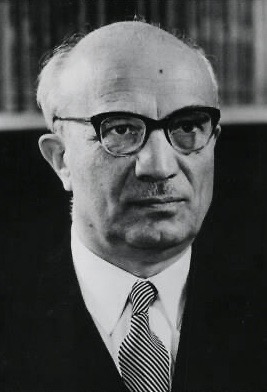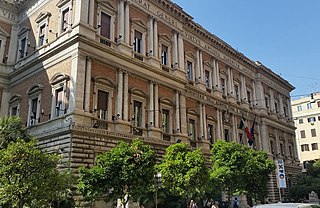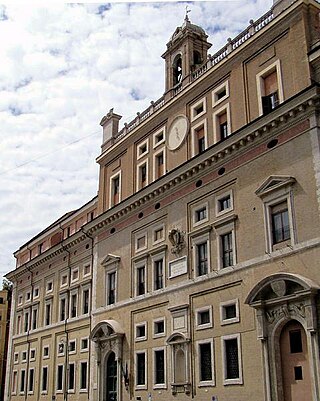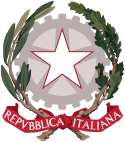Typical structure
The minister [ it ] (ministro, from Latin minister, 'assistant') is the head of the ministry and is a member of the political class. The minister proposes the appointment of directors with general functions to the Council of Ministers, directs administrative action, and takes decisions on important matters. There are also ministers without portfolio for competencies that do not come with budgetary autonomy (e.g. the Minister for relations with Parliament).
The Under-secretary (sottosegretario) is also appointed from the political class. The title derives from the fact that the minister is a Secretary of State. However, the Under-secretary is only an assistant to the minister - they aid the minister but cannot act in their stead. A ministry may have multiple Under-secretaries. Under-secretaries do not have any powers of their own, but only those delegated to them by the minister. If the powers conferred on an Under-secretary comprise a whole department of the ministry, they may be given the title of Deputy Minister.
The Cabinet of the Minister (gabinetto del ministro) consists of the Head of the cabinet, the legislative office, and the specific secretariat, each with its own head. When the government changes, the members of the cabinet also change. The cabinet is empowered to assist the minister and co-ordinate activities of the ministry.
The board of administration (consiglio di amministrazione) is chaired by the minister and composed of general directors and elected representatives of the personnel. It has an established structure and powers related to the organisation of labour in the ministry.
The General Secretary (segretario generale) is only present in some ministries (e.g. the Ministry of Foreign Affairs) and has powers relating to co-ordination.
Subdivisions of the ministry include departments, general directorates, divisions, etc. They are different in every ministry. Usually, the department [ it ] (dipartimento or reparto) is the highest level sub-division of the ministry, and the general directorate (direzione generale) is a second-order sub-division. In some ministries, however, there are no departments and the general directorates are the highest level sub-division. The basic units of the ministry are the divisions (divisioni), which may be divided into sections (sezioni).
History
The number of the ministries has varied over time from 20 to 25, including the ministers without portfolio.
The first attempt at structural reform of the Presidency of the Council, the structure of the Council of Ministers, and the arrangement of the ministers was put forward by Franco Bassanini, Minister of Public Administration in the Prodi I Cabinet, with legislative decree n. 300 of 30 July 1999. This measure outlined a new form of ministerial organisation, moving in three different directions.
First of all, it reduced the size of the ministerial apparatus: the ministries were reduced to twelve, the civil service was transformed into a single body, to order to ensure its mobility. The principle of organisational flexibility was strongly asserted, through broad deregulation of the ministries' organisation, except for the functions of the ministers and the number of their subdivisions. Secondly, in order to ensure polycentrism, twelve independent agencies were established with technical operational functions, which require particular expertise, specialist knowledge, or specific forms of labour organisation. Thirdly, local offices of the state administration were all placed in the newly created Territorial Offices of the Government (UTG), which absorbed the prefectures [ it ].
The reform was meant to come into force in the 14th legislature, but it did not completely do so, since the Berlusconi II Cabinet modified the reforms on taking power. The ministries were expanded. Only a few of the proposed agencies were actually created: the Protezione Civile, Agency of Revenue, Agency of Customs and Monopolies [ it ], the Land Agency [ it ] (abolished in 2012), the Agency of State Property [ it ] (merged into the Ministry of Finance in 2003), and the Agency for the Protection of the Environment and for Technical Services [ it ] (abolished in 2008).
The 'unpacking' of 2001
Under decree law n.217/2001 (converted into law n.317/2001), the Berlusconi II cabinet increased the number of ministries to fourteen.
- The Ministry of Labour, Health and Social Policy was split into the Ministry of Health and the Ministry of Labour and Social Policy.
- The Ministry of Communications was separated out of the Ministry of Productive Activities.
The 'unpacking' of 2006
Under decree law n.181/2006 (converted into law 233/2006), the Prodi II Cabinet increased the number of ministries to eighteen:
In the 2008 budget, in response to criticism of the record number of government ministers and the cost of politicians, the 16th legislature returned to the spirit of the Bassanini reforms of 1999 with some amendments, returning to twelve ministries.
- Ministry of Foreign Affairs
- Ministry of the Interior
- Ministry of Justice
- Ministry of Defence
- Ministry of Economy and Finance
- Ministry of Economic Development
- Ministry of Agricultural, Food, and Forestry Policy
- Ministry of the Environment and Protection of Land and Sea
- Ministry of Infrastructure and Transport
- Ministry of Labour, Health, and Social Policy
- Ministry of Education, Universities, and Research
- Ministry for Cultural Heritage and Activities
The maximum number of ministers, ministers without portfolio, deputy ministers, and under-secretaries in the government was fixed at sixty. The reformed system came into effect with the beginning of the Berlusconi IV Cabinet.
Modifications of 2009
Under law n. 172/2009 of 13 November, the Ministry of Labour, Health, and Social Policies was split into the Ministry of Labour and Social Policies and the Ministry of Health, bringing the number of ministries to thirteen and the total number of members of government to sixty-three. This latter number was increased to 65 under article 15.3 bis of decree law n. 159/2009 of 30 December (converted into law n.26/2010).
Modifications under the Renzi government
In 2013, the Ministry for Cultural Heritage and Activities absorbed competencies relating to tourism and its name was altered to reflect this. In 2014, the name of the Ministry of Foreign Affairs was changed to the Ministry of Foreign Affairs and International Co-operation.

Amintore Fanfani was an Italian politician and statesman, who served as 32nd prime minister of Italy for five separate terms. He was one of the best-known Italian politicians after the Second World War and a historical figure of the left-wing faction of Christian Democracy. He is also considered one of the founders of the modern Italian centre-left.

Enrico Letta is an Italian politician who served as Prime Minister of Italy from April 2013 to February 2014, leading a grand coalition of centre-left and centre-right parties. He was the leader of the Democratic Party (PD) from March 2021 to March 2023. He is currently the Dean of IE University’s School of Politics, Economics and Global Affairs in Madrid, Spain.

The Ministry of Defence is the government body of the Italian Republic responsible for military and civil defence matters and managing the Italian Armed Forces. It is led by the Italian Minister of Defence, a position occupied by Guido Crosetto since October 2022.

Enrico Giovannini is an Italian economist, statistician and academic, member of the Club of Rome. Since February 2021, he has been serving as Minister of Infrastructure and Sustainable Mobility in the Draghi Government. From April 2013 to February 2014, he served as Minister of Labour and Social Policies in the Letta Government. From 2009 to 2013, he held the office of President of the Italian National Institute of Statistics (Istat).

The Ministry of Agriculture, Food Sovereignty and Forests, Italian: Ministero dell'agricoltura, della sovranità alimentare e delle foreste or MASAF, is an Italian government department.

The Ministry of Culture is the ministry of the Government of Italy in charge of national museums and the monuments historiques. MiC's headquarters are located in the historic Collegio Romano Palace and the current Minister of Culture is Alessandro Giuli.

The Ministry of Education and Merit is the government body of Italy devoted to the administration of the national education system.
The Ministry of Education and Merit is the ministry of the Italian government for the national education system, the Italian universities and research agencies. The current Italian Minister of Public Education is Giuseppe Valditara and the Italian Minister of University and Research is Anna Maria Bernini.

The Ministry of Infrastructure and Transport is the government ministry for transport in the Republic of Italy. It is responsible for all transport infrastructure as well as general transport planning and logistics, especially for urban transport schemes, with a particular attention at their sustainability. It is led by the Italian Minister of Sustainable Infrastructures and Mobility.

The Ministry of Enterprises and Made in Italy, commonly known under the shortening of its pre-2022 name, MISE, is a government ministry of the Italian Republic. It deals with production, economic activities, energy and mineral resources, telecommunications, consumers, tourism, internationalisation and business incentives. It was formed in 2006 after the reorganization of the Ministry of Productive Activities to which were merged the Ministry of Communications and the Ministry of International Trade in 2008.

The Ministry of the Interior is a government agency of Italy, headquartered in Rome. It is a cabinet-level ministry of the Italian Republic. As of October 2022, Matteo Piantedosi, former Prefect of Rome, is the minister.

The Ministry of Economy and Finance, also known by the acronym MEF, is a ministry of the Italian government. Its responsibilities include overseeing economic policy, public investments and spending. The Ministry's headquarters are located in Rome's historic Palazzo delle Finanze. The current minister in the Meloni Cabinet is Giancarlo Giorgetti.
The Liberal Socialist Movement, called until 18 December 1994 the Federation of Socialists, was a social-democratic political party in Italy.

Michel Martone is an Italian jurist and academic. He was Deputy Minister for Labor and Welfare from 29 November 2011 to 28 April 2013. On his first assignment, his delegations were active and passive labor market policies, youth employment, vocational training, industrial and labor relations.

Andrea Orlando is an Italian politician who served as minister of labour and social policies from 2021 to 2022 in the cabinet led by Prime Minister Mario Draghi. From 2013 to 2014 he served as minister of the environment under Enrico Letta and as minister of justice under Matteo Renzi and Paolo Gentiloni from 2014 to 2018. He served as deputy secretary of the Democratic Party between 2019 and 2021.

The Ministry of Labour and Social Policies is a department of the government of the Republic of Italy responsible for policies of labour, employment, labour protection, the adequacy of social security system, and social policy, with particular reference to the prevention and reduction of conditions of need and distress among the people.

The Presidency of the Council of Ministers is the administrative structure which supports the Prime Minister of Italy. It is thus the Italian equivalent of the Prime Minister's Office. It contains those departments which carry out duties invested in the office of the Prime Minister. Duties invested in the Italian executive government generally are not administered by the Presidency, but by the individual ministries.

This is a list of ministers of labour and social policies, a senior member of the Italian government who leads the Ministry of Labour and Social Policies. The list shows also the ministers that served under the same office but with other names, in fact this Ministry has changed name many times.

Francesco D'Onofrio is an Italian politician and academic, former Minister of Public Education in the Berlusconi I Cabinet.

In the Italian government, ministers without portfolio are nominated by the President of the Council of Ministers and formally appointed by the President of the Republic to lead particular departments directly under the Presidency of the Council of Ministers. Unlike the office of State Undersecretary to the Presidency, who fulfills duties in the Prime Minister's remit, ministers without portfolio enjoy the full status of ministers but do not lead an independent ministry. Departments on equalities, European affairs, and relations with regions, for example, are usually led by ministers without portfolio.


















